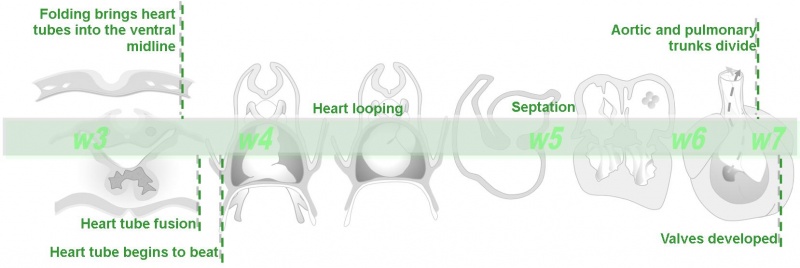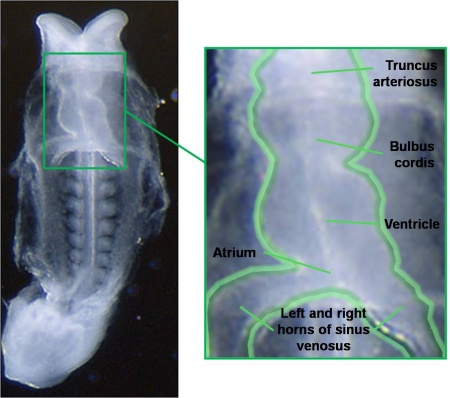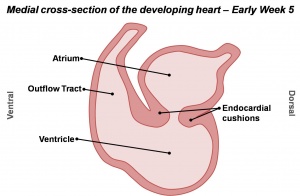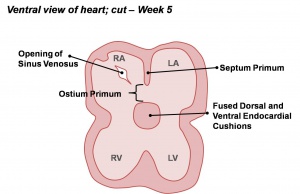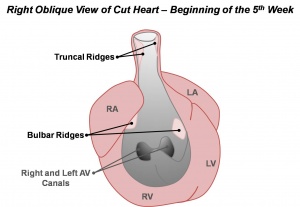Basic - Embryonic Heart Divisions: Difference between revisions
No edit summary |
mNo edit summary |
||
| (15 intermediate revisions by 3 users not shown) | |||
| Line 3: | Line 3: | ||
{{ | {{Cardiac_modules}} | ||
[[Image:Basic Heart Development Timeline.jpg|center|800px]] | |||
[[Image: | |||
From here we can see the primitive heart from a ventral view as it consists of the two tubes. These tubes fuse together (as seen in the diagram on the right) to form a single, primordial heart tube | [[Image:Divisions of Early Heart Tube.jpg|thumb|right|upright=1.5|22 day embryo showing segments of heart tube]] | ||
From here we can see the primitive heart from a ventral view as it consists of the two tubes. These tubes fuse together (as seen in the diagram on the right) to form a single, primordial heart tube situated in the midline of the embryo, ventral to the '''pharynx'''. | |||
==Segments of the Heart Tube== | ==Segments of the Heart Tube== | ||
At this stage | At this stage the tube already has minor constrictions within it, indicating sections of the heart tube that will form parts of the adult heart. The most '''caudal''' (tail end) segment of the heart tube is the '''sinus venosus''' which will later become the ends of the major veins carrying blood to the heart as well as parts of the atria. The next segments are the '''primitive atrium''' and '''primitive ventricle''' which will become the atria and ventricles of the adult heart. Cranial to these segments are the '''bulbus cordis''', most of which will become the right ventricle, and the '''truncus arteriosus''' which forms the '''pulmonary''' and '''aortic''' trunks carrying blood away from the heart. | ||
===Heart Tube Looping=== | ===Heart Tube Looping=== | ||
This tubular heart undergoes a process of looping during week four of development to form a shape that resembles that of the adult heart. It initially forms a C-shape (with the convex portion of the C situated on the right side of the embryo) and then an S-shape. Eventually the atria are brought backwards and upwards | This tubular heart undergoes a process of looping during week four of development to form a shape that resembles that of the adult heart. It initially forms a ''C-shape'' (with the convex portion of the C situated on the right side of the embryo) and then an ''S-shape''. Eventually the atria are brought backwards and upwards so that they lie cranially and behind the ventricles. The following animation outlines this process. | ||
< | <html5media height="560" width="720">File:Heart looping 005.mp4</html5media> | ||
---- | |||
==Septation of the Heart== | ==Septation of the Heart== | ||
| Line 25: | Line 28: | ||
The internal heart then undergoes significant changes in order to form the atria and ventricles of the adult heart. These can be summarised as follows: | The internal heart then undergoes significant changes in order to form the atria and ventricles of the adult heart. These can be summarised as follows: | ||
{| | {| align=center | ||
|- style="background:lightsteelblue" | |- style="background:lightsteelblue" | ||
|Cells from the dorsal and ventral (back and front) walls of the heart grow and form two protrusions called the endocardial cushions. These grow towards each other and fuse to form the left and right atrioventricular canals. | |'''1.''' Cells from the dorsal and ventral (back and front) walls of the heart grow and form two protrusions called the '''endocardial cushions'''. These grow towards each other and fuse to form the left and right '''atrioventricular canals'''. | ||
|[[Image: | |[[Image:AV Canal Division.jpg|thumb|Division of the atrioventricular canal]] | ||
| | |'''2.''' Within the primordial atrium a septum (the '''septum primum''') grows towards the endocardial cushions. The space between the cushions and septum is known as the '''foramen primum'''. As the foramen primum decreases in size a second opening forms in the septum: the '''foramen secundum'''. | ||
|[[Image:Atrial Septation.jpg|thumb|center|Early atrial septation]] | |||
|[[Image: | |||
|- | |- | ||
|A primordial muscular ridge exists in the floor of the ventricle. As the left and right ventricles grow, their medial (midline) walls fuse to form the interventricular septum. | |'''3.''' A second septum ('''septum secundum''') develops on the right of the septum primum. | ||
|[[Image: | |[[Image:Atrial & Ventricular Septation 1.jpg|thumb|center|Atrial and ventricular septation]] | ||
|'''4.''' A primordial muscular ridge exists in the floor of the ventricle. As the left and right ventricles grow, their medial (midline) walls fuse to form the '''interventricular septum'''. | |||
|[[Image:Atrial & Ventricular Septation 2.jpg|thumb|center|Atrial and ventricular septation]] | |||
|-style="background:lightsteelblue" | |-style="background:lightsteelblue" | ||
|Within the bulbus cordis and truncus arteriosus, which form the outflow tract, small ridges develop. They are continuous throughout the outflow tract and form a spiral shape. | |'''5.''' Within the '''bulbus cordis''' and '''truncus arteriosus''', which form the '''outflow tract''', small ridges develop. They are continuous throughout the outflow tract and form a spiral shape. | ||
|[[Image: | |[[Image:Basic Conotruncal Ridge Development.jpg|thumb|center|Development of the conotruncal ridges]] | ||
| | |'''6.''' As these ridges fuse they create a spiral shaped septum throughout the outflow tract. The original outflow tract is therefore separated into both the '''aorta''' and '''pulmonary trunk'''. | ||
|[[Image:Basic Outflow Tract Division.jpg|thumb|center|Division of the outflow tract forms the aorta and pulmonary trunk]] | |||
|[[Image: | |||
|} | |} | ||
Thus the heart begins to resemble the adult heart in that it has two atria, two ventricles and the aorta forming a connection with the left ventricle | Thus the heart begins to resemble the adult heart in that it has two atria, two ventricles and the aorta forming a connection with the left ventricle while the pulmonary trunk forms a connection with the right ventricle. | ||
{| width="100%" | {| width="100%" | ||
| Line 59: | Line 59: | ||
|bgcolor="gold" align="right"|<big>'''[[Intermediate_-_Atrial_Ventricular_Septation|Go to this section in the intermediate level]]'''</big> | |bgcolor="gold" align="right"|<big>'''[[Intermediate_-_Atrial_Ventricular_Septation|Go to this section in the intermediate level]]'''</big> | ||
|} | |} | ||
{{Glossary}} | |||
'''Aorta:''' The largest artery in the human body originating in the left ventricle. The aorta ascends, arches over the heart and then descends through the abdomen. | |||
'''Atrioventricular canal:''' Junction between the primitive atrium and primitive ventricle in the embryo. This canal splits to later form two atrioventricular canals which consequently form the valves of the adult heart. | |||
'''Caudal:''' Anatomical term referring to structures that are more towards the tail. | |||
'''Cranial:''' Anatomical term referring to structures that are more towards the head. | |||
'''Dorsal:''' Anatomical term referring to structures that are more towards the back. | |||
'''Endocardial cushions:''' Swellings of migrated cells on the inner lining of the heart. | |||
'''Foramen primum:''' Original space between the septum primum and the fused endocardial cushions as the septum primum grows towards the cushions. | |||
'''Foramen secundum:''' Refers to the coalesced perforations in the septum primum after it has fused with the endocardial cushions. | |||
'''Interventricular septum:''' Wall of muscular tissue growing from the base of the heart dividing the primitive ventricle into the left and right ventricles. | |||
'''Lateral:''' Anatomical term referring to structures that are away from the midline. | |||
'''Left atrium:''' Upper cavity in the left side of the heart. The left atrium forms from the division of the primitive atrium into left and right sides. | |||
'''Left ventricle:''' Lower cavity on the left side of the heart. The left ventricle forms from the division of the primitive ventricle into left and right sides. | |||
'''Medial:''' Anatomical term referring to structures towards the midline. | |||
'''Outflow tract:''' Section of the heart tube where blood exits. The outflow tract forms the major arteries leaving the heart to supply blood to the lungs and rest of the body: the pulmonary artery and the aorta. | |||
'''Pharynx:''' (Or throat) Forms the initial segment of the upper respiratory tract divided anatomically into three regions: nasopharynx, oropharynx, and laryngopharynx (hypopharynx). Anatomically extends from the base of the skull to the level of the sixth cervical vertebra. | |||
'''Primitive atrium:''' Common cavity in the upper portion of the developing heart. Later divides to form the left and right atria. | |||
'''Primitive ventricle:''' Common cavity in the lower portion of the developing heart. Later divides to form the left and right ventricles. | |||
'''Pulmonary trunk:''' A vessel that arises from the right ventricle of the heart, extends upward, and divides into the right and left pulmonary arteries that transport deoxygenated blood to the lungs. | |||
'''Right atrium:''' Upper cavity in the right side of the heart. The right atrium forms from the division of the primitive atrium into left and right sides. | |||
'''Right ventricle:''' Lower cavity on the right side of the heart. The right ventricle forms from the division of the primitive ventricle into left and right sides. | |||
'''Septum primum:''' Original structure growing from the roof of the heart towards the endocardial cushions dividing the primitive atrium. | |||
'''Septum secundum:''' Second structure growing to the right of the septum primum dividing the primitive atrium. | |||
'''Sinus venosus:''' An early developmental cardiovascular structure, thin walled cavity, forming the input to developing heart which has 3 venous inputs (vitelline vein, umbilical vein, common cardinal vein). Later in heart development this structure gets incorporated into the wall of the future right atrium. | |||
'''Ventral:''' Anatomical term referring to structures that are more towards the front. | |||
[[category:heart]] | |||
Latest revision as of 08:34, 20 April 2020
| Begin Basic | Primitive Heart Tube | Embryonic Heart Divisions | Vascular Heart Connections |
| Cardiac Embryology | Begin Basic | Begin Intermediate | Begin Advanced |
From here we can see the primitive heart from a ventral view as it consists of the two tubes. These tubes fuse together (as seen in the diagram on the right) to form a single, primordial heart tube situated in the midline of the embryo, ventral to the pharynx.
Segments of the Heart Tube
At this stage the tube already has minor constrictions within it, indicating sections of the heart tube that will form parts of the adult heart. The most caudal (tail end) segment of the heart tube is the sinus venosus which will later become the ends of the major veins carrying blood to the heart as well as parts of the atria. The next segments are the primitive atrium and primitive ventricle which will become the atria and ventricles of the adult heart. Cranial to these segments are the bulbus cordis, most of which will become the right ventricle, and the truncus arteriosus which forms the pulmonary and aortic trunks carrying blood away from the heart.
Heart Tube Looping
This tubular heart undergoes a process of looping during week four of development to form a shape that resembles that of the adult heart. It initially forms a C-shape (with the convex portion of the C situated on the right side of the embryo) and then an S-shape. Eventually the atria are brought backwards and upwards so that they lie cranially and behind the ventricles. The following animation outlines this process.
<html5media height="560" width="720">File:Heart looping 005.mp4</html5media>
Septation of the Heart
The internal heart then undergoes significant changes in order to form the atria and ventricles of the adult heart. These can be summarised as follows:
| 1. Cells from the dorsal and ventral (back and front) walls of the heart grow and form two protrusions called the endocardial cushions. These grow towards each other and fuse to form the left and right atrioventricular canals. | 2. Within the primordial atrium a septum (the septum primum) grows towards the endocardial cushions. The space between the cushions and septum is known as the foramen primum. As the foramen primum decreases in size a second opening forms in the septum: the foramen secundum. | ||
| 3. A second septum (septum secundum) develops on the right of the septum primum. | 4. A primordial muscular ridge exists in the floor of the ventricle. As the left and right ventricles grow, their medial (midline) walls fuse to form the interventricular septum. | ||
| 5. Within the bulbus cordis and truncus arteriosus, which form the outflow tract, small ridges develop. They are continuous throughout the outflow tract and form a spiral shape. | 6. As these ridges fuse they create a spiral shaped septum throughout the outflow tract. The original outflow tract is therefore separated into both the aorta and pulmonary trunk. |
Thus the heart begins to resemble the adult heart in that it has two atria, two ventricles and the aorta forming a connection with the left ventricle while the pulmonary trunk forms a connection with the right ventricle.
| Back to the Primitive Heart Tube | Next: Vascular Connections | |
| Go to this section in the intermediate level |
Glossary Links
- Glossary: A | B | C | D | E | F | G | H | I | J | K | L | M | N | O | P | Q | R | S | T | U | V | W | X | Y | Z | Numbers | Symbols | Term Link
Aorta: The largest artery in the human body originating in the left ventricle. The aorta ascends, arches over the heart and then descends through the abdomen.
Atrioventricular canal: Junction between the primitive atrium and primitive ventricle in the embryo. This canal splits to later form two atrioventricular canals which consequently form the valves of the adult heart.
Caudal: Anatomical term referring to structures that are more towards the tail.
Cranial: Anatomical term referring to structures that are more towards the head.
Dorsal: Anatomical term referring to structures that are more towards the back.
Endocardial cushions: Swellings of migrated cells on the inner lining of the heart.
Foramen primum: Original space between the septum primum and the fused endocardial cushions as the septum primum grows towards the cushions.
Foramen secundum: Refers to the coalesced perforations in the septum primum after it has fused with the endocardial cushions.
Interventricular septum: Wall of muscular tissue growing from the base of the heart dividing the primitive ventricle into the left and right ventricles.
Lateral: Anatomical term referring to structures that are away from the midline.
Left atrium: Upper cavity in the left side of the heart. The left atrium forms from the division of the primitive atrium into left and right sides.
Left ventricle: Lower cavity on the left side of the heart. The left ventricle forms from the division of the primitive ventricle into left and right sides.
Medial: Anatomical term referring to structures towards the midline.
Outflow tract: Section of the heart tube where blood exits. The outflow tract forms the major arteries leaving the heart to supply blood to the lungs and rest of the body: the pulmonary artery and the aorta.
Pharynx: (Or throat) Forms the initial segment of the upper respiratory tract divided anatomically into three regions: nasopharynx, oropharynx, and laryngopharynx (hypopharynx). Anatomically extends from the base of the skull to the level of the sixth cervical vertebra.
Primitive atrium: Common cavity in the upper portion of the developing heart. Later divides to form the left and right atria.
Primitive ventricle: Common cavity in the lower portion of the developing heart. Later divides to form the left and right ventricles.
Pulmonary trunk: A vessel that arises from the right ventricle of the heart, extends upward, and divides into the right and left pulmonary arteries that transport deoxygenated blood to the lungs.
Right atrium: Upper cavity in the right side of the heart. The right atrium forms from the division of the primitive atrium into left and right sides.
Right ventricle: Lower cavity on the right side of the heart. The right ventricle forms from the division of the primitive ventricle into left and right sides.
Septum primum: Original structure growing from the roof of the heart towards the endocardial cushions dividing the primitive atrium.
Septum secundum: Second structure growing to the right of the septum primum dividing the primitive atrium.
Sinus venosus: An early developmental cardiovascular structure, thin walled cavity, forming the input to developing heart which has 3 venous inputs (vitelline vein, umbilical vein, common cardinal vein). Later in heart development this structure gets incorporated into the wall of the future right atrium.
Ventral: Anatomical term referring to structures that are more towards the front.
